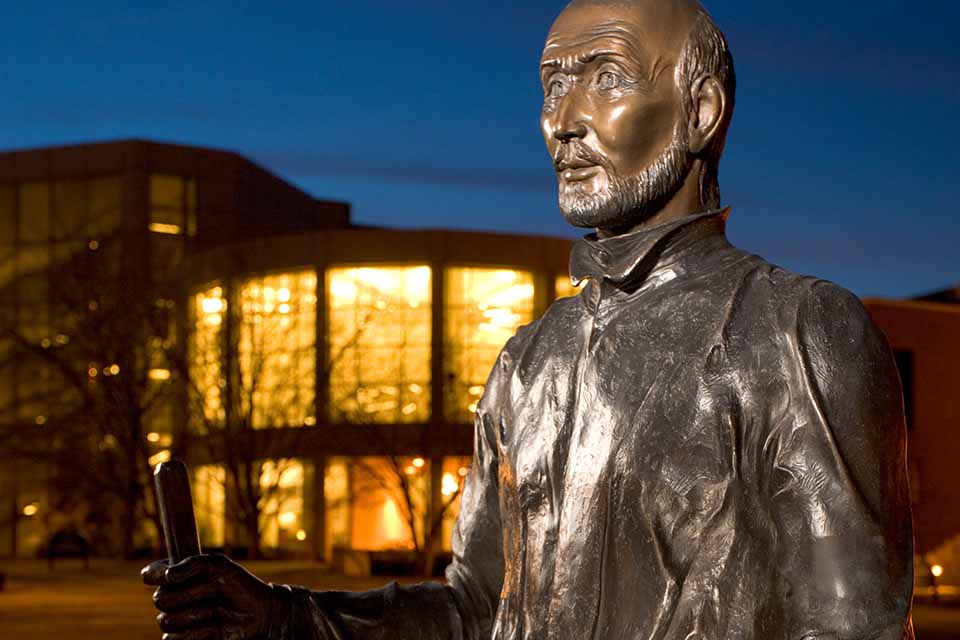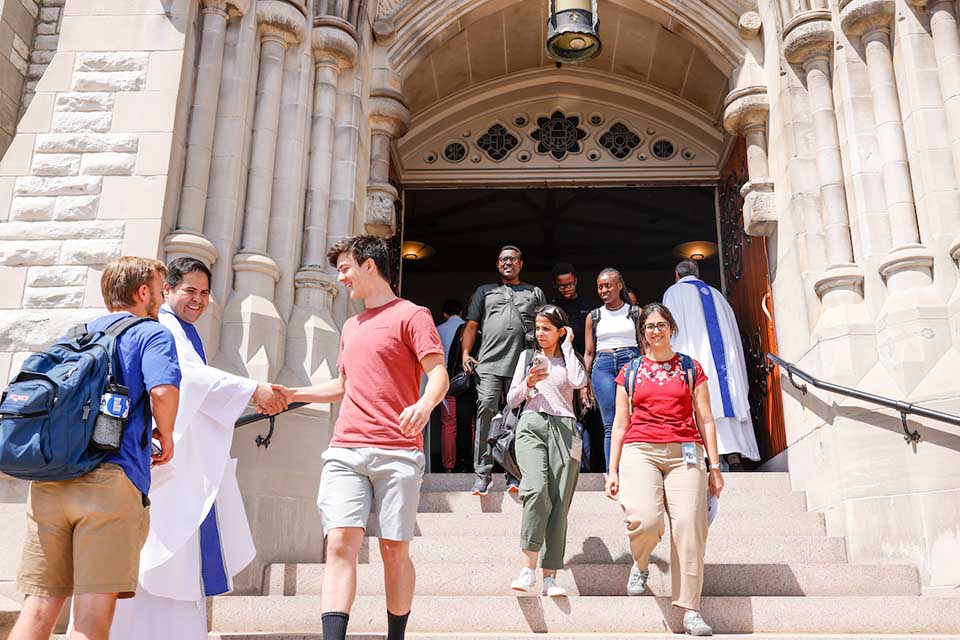About SLU's Catholic, Jesuit Identity
In 1818, Catholic Bishop Louis William DuBourg founded Saint Louis University, the first institution of higher learning west of the Mississippi River. Less than a decade later, the Society of Jesus assumed control of the University. Ever since, the Catholic and Jesuit traditions have guided the University to serve a higher purpose and to seek the greater good.
Making the World a Better Place
Saint Louis University follows the Jesuit traditions of educating the whole person — mind, body and spirit — and preparing students to make the world a better place.
At SLU, we encourage asking hard questions and looking beyond easy answers. What does ethical leadership look like in the 21st century? How can we help improve the lives of the incarcerated or underprivileged children in St. Louis? How do we work to end systemic racial inequity?
- Office of Mission and Identity
- Campus Ministry
- Center for Social Action
- Division of Diversity and Innovative Community Engagement
Explore SLU's Mission
How Does Jesuit Education Work?
SLU doesn’t just talk the talk — we walk the walk. Our undergraduates are encouraged to take a broad range of classes, and every major is founded upon a core curriculum that includes theology and philosophy. But whatever the topic, students learn to defend ideas and to improve upon them, developing the skills to think clearly, argue persuasively and express themselves coherently.
Inspired by the Jesuit call to be men and women for others, at SLU ideas become actions, and serving others is a way of life. More than 80 of SLU’s courses directly integrate service into academic content. Outside of the classroom, students, faculty and staff members devote more than 1.6 million hours to community service annually.
In and out of class, on campus and around the globe, SLU students come to see the future as a wondrous opportunity for growth and good works.
At Saint Louis University, the nearly 500-year-old Jesuit tradition inspires everything from the kinds of classes students take to how they spend their free time. But just what does it mean to be “Jesuit”?
FAQ About the Jesuit Tradition
The Jesuits are members of the Society of Jesus, a Roman Catholic religious order founded in 1540 by St. Ignatius of Loyola.
Early on, the Jesuits became known for education as they traveled throughout Europe
doing missionary work and starting schools and seminaries. Less than two decades after
they were founded, Jesuits had established 74 colleges on three continents.
Today, there are close to 200 Jesuit institutions of higher learning around the world,
including Saint Louis University. The Society of Jesus is the largest male religious
order in the Catholic Church, with almost 17,000 priests and brothers worldwide. They
are teachers as well as pastors, lawyers and more. In fact, Pope Francis is a Jesuit
priest.
Nearly 30 Jesuit priests and brothers live, teach and minister at Saint Louis University. In addition, Bellarmine House of Studies, one of only three houses of Jesuit First Studies in the country, is an on-campus residential community for 25 scholastics in training. Jesuit Hall is home to priests who work on campus, as well as some who have retired from teaching or ministry.
Jesuit education entails caring for the whole person — mind, body and spirit — and encouraging students to become well-rounded people who contribute to the greater good.
Inspired by the Jesuit practice of “finding God in all things,” students take a broad range of study, which is grounded in the theological and philosophical foundations of the Catholic intellectual tradition.
Then there’s the idea of “the magis” (more), which leads to excellence in all pursuits. This ties into the Jesuit legacy of academic rigor, which requires students to go deeper, think critically and solve problems creatively for the glory of God and the service of humanity.
Finally, Jesuit education prepares students to become “men and women for and with others,” to make the world a better place by seeking justice and serving the most vulnerable among us.
All undergraduates take a course that is unique to SLU called “Theological Foundations.” The course is an exploration of the Judeo-Christian religious traditions that have contributed to shaping cultures throughout the world for more than 3,000 years. Connections are also made in this course to other major religious traditions alive and well today.
No. While there is ample opportunity for Catholic students to go to Mass, other students are welcome but not obligated to join them. The Department of Campus Ministry also works with affiliate ministers of many faith traditions who accompany students on their spiritual journeys, on and off campus.
Inigo de Loyola (1491-1556) was the youngest child of a noble Basque family loyal to the Spanish crown. He spent his early days not as a priest but as a courtier and a soldier. During the battle of Pamplona in 1521, his leg was seriously wounded by a cannonball. While he recuperated at his family’s home, he reconsidered his way of life. A spiritual and religious conversion followed, and he decided to lay aside his sword of war and take up what he called the "sword of Christ."

After his convalescence, Ignatius began his new life as a pilgrim. He stopped in a town called Manresa, intending to stay for a few days. Instead, he stayed for 10 months, spending hours each day in prayer. This led to the creation of what is now known as the “Spiritual Exercises.” Also during this time, Ignatius had a vision that led him to seek “to find God in all things.”
After his religious conversion, to be of greater assistance to others, he went back to school, studying at a variety of different universities. While at the University of Paris, he formed a circle of friends who decided to dedicate themselves to the greater glory of God and “helping souls.” They placed themselves at the service of the Pope, who would send them throughout the world, wherever they were needed most. Everywhere the Jesuits went, their mission remained the same: to seek the greater glory of God and the good of humanity.
St. Ignatius was canonized by Pope Gregory XV on March 12, 1622. His feast day is celebrated on July 31, the day he died.


















